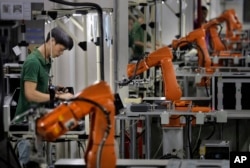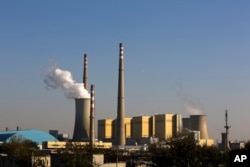After heavy smog cloaked the cities of eastern China in recent years, Beijing vowed to cut air pollution, and the government's efforts seem to be having an impact, with some help from the slowing economy.
China's coal consumption dropped 3.7 percent in 2015, following a drop of nearly 3 percent the year before.
"China is very serious about tackling air pollution, which is leading to all kinds of measures targeting the most important polluting sectors," said Lauri Myllyvirta, a senior global coal campaigner at Greenpeace.
Coal burning is the biggest source of carbon dioxide emissions, and falling consumption has helped reduce the country's emissions. China is the world's top emitter of greenhouse gases, and emissions soared over the past two decades of rapid economic growth.
But last year, China's carbon dioxide emissions fell 2.5 percent.
Clean energy leads to drop in coal consumption
China's shift to clean energy sources such as hydro, nuclear and solar have resulted in a drop in coal consumption and emissions, as has the country's slowing economy, which increasingly relies less on heavy industry such as construction, steel and cement production.
The government's efforts to transform the economy away from manufacturing and towards the service sector also means factories need less coal to fuel their declining production.
China's economic transition will take several years, and environmentalists like Ma Jun say more work needs to be done.
"If we truly want to reduce coal consumption and our carbon emissions, we need to restructure our industries which are still focused on energy intensive industry," said Ma.
Changing energy sources poses challenges
As China balances the need to restructure its economy with the potential of high unemployment and social instability, maintaining the decline of coal consumption and carbon dioxide emissions could be a challenge.
Last week, China announced 1.8 million workers in the steel and cement industries will lose their jobs, as the government shuts down so-called "zombie" factories and companies that produce little output.
Local governments, fearful of labor protests and needing to prop up employment and GDP, have proposed the construction of more than 200 coal plants across the country.
Transition to less use of coal will not be easy
Peter Marsters, a Research Analyst at Rhodium Group which focuses on Chinese environmental and energy issues, said this tension between the current transition in China's economy and the demands for economic stimulus will determine whether coal consumption has reached its peak.
"You know what we're really looking at in the energy story is just the transition from energy intensive growth to service sector, less energy intensive growth, and how China completes that transition will be the story of energy and climate for the next 10 years," he said.
China has announced big goals for emission reduction over the next several years. The government says 20 percent of China's total energy use will be from carbon-free sources by 2030. President Xi Jinping has announced that China's greenhouse gas emissions will peak by that year as well.










